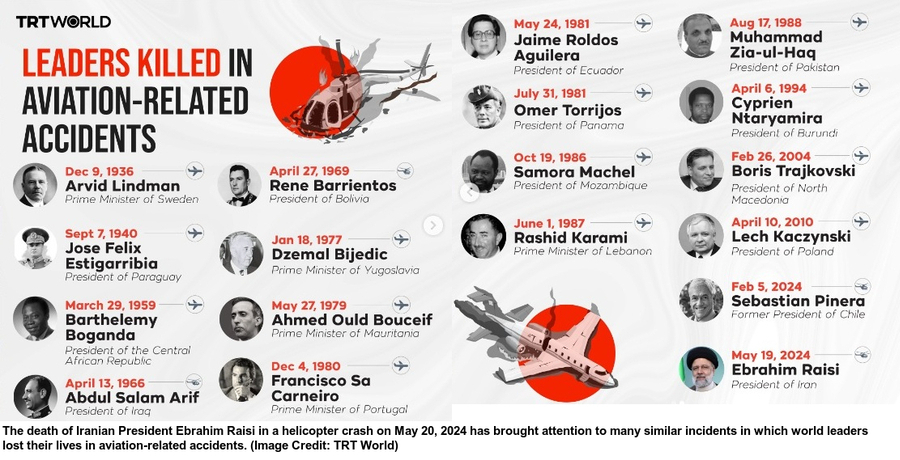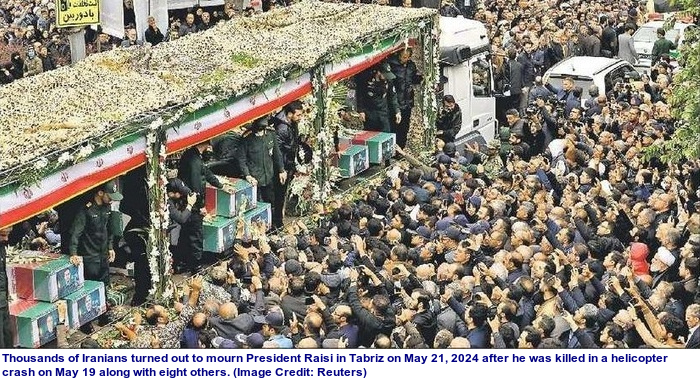The ‘Invisible’ Hands Behind Raisi’s Death
The Iranian state news agency, as well as Reuters, reported on May 19, 2024 that Iranian President Ebrahim Raisi was killed, alongside his Foreign Minister Hossein Amir-Abdollahian and some other top government officials, in a helicopter crash. The two agencies also reported that the helicopter crashed after hitting a mountain, claiming that the visibility was very poor at the time of the accident due to heavy rains and dense fog. Hence, President Raisi’s shocking demise was believed to be an accident, apparently!
A couple of days after the incident, a section of Iranian officials hinted that Israel could be behind the crash of President Raisi’s helicopter! They are of the opinion that Mossad, the national intelligence agency of the State of Israel, might have plotted the crash on May 19 night!

The ill-fated helicopter, carrying Raisi, Abdollahian and other Iranian officials, met with the accident while crossing the mountainous terrain in heavy fog on its way to the Iranian city of Tabriz. Earlier, the President took part in the inauguration of the Qiz Qalasi Dam on the Iranian-Azerbaijani border. On May 20 (2024), rescue teams found no sign of life after locating the crash site close to the border with Azerbaijan, about 375 miles from the Iranian capital of Tehran. All they could locate were the charred bodies of the Iranian President and others early on May 20 near the mountains close to the Azerbaijan border after an overnight search.
Interestingly, relations between Iran and neighbouring Azerbaijan have always been cold mainly because of the former Soviet Republic’s close ties with Israel. Azerbaijan even has a history of helping the Mossad on various occasions! The Conspiracy Theorists have opined that Azerbaijan could help the Israeli intelligence agency to plot the assassination. However, others have claimed that neither the Jewish Nation nor the Mossad have ever directly targeted a Head of the State. Instead, the Mossad, Aman and Shin Bet are famous for destroying the military infrastructure of the enemies or destroying their economic interests by carrying out surprise attacks. At the same time, they have admitted that the Mossad could have changed its policy as the person was Ebrahim Raisi this time! Speculations are rife as to whether Raisi, a controversial political character, has incurred the wrath of an enemy because of his aggressive foreign policy. Anyone in factionally-divided Iran could also have conspired to eliminate Raisi.

As expected, Israel has denied its (direct or indirect) involvement in the helicopter crash on May 19 night. Although the Islamic Republic is yet to point the blame at anyone else, an Israeli official (who wished to remain anonymous) told the Reuters on May 20: “It wasn’t us.“
Meanwhile, the White House stated that President Raisi had “blood on his hands” as he used to support extremist groups in West Asia. Speaking at a press conference, National Security Spokesperson of White House John Kirby stressed: “No question this was a man who had a lot of blood on his hands. The US will continue to hold Iran accountable for the destabilising activity in the region.“

The ‘Carrier’ In The Fateful Night
It may be noted that the helicopter which was carrying President Raisi on May 19 night is known as Bell. These choppers have been made modern and up-to-date in recent times and given a new name – Bell Textron. The manufacturer of the helicopter is Bell Textron Inc., a US aerospace manufacturing company headquartered in Fort Worth, Texas. It is specially known as Utility Helicopter (UH). The Bell helicopter was developed in the late 1960s as an upgraded version of the Iroquois (nicknamed Huey) helicopter, a member of the UH-1 family. Initially, the Canadian Armed Forces used Bell helicopters for military purposes. Later, the US also started using it. Although a US company is the manufacturer of this helicopter, it was first used in Canada. The latest version of this chopper has two engines, instead of one. Hence, the carrying capacity of it has increased.
Incidentally, the Bell 212 helicopters used by Iran are quite old. In fact, most of Iran’s aircraft or helicopters are old. As the US and its Western partners have imposed economic sanctions on Iran, the Islamic Republic faces difficulties in importing equipment of modern aircraft and helicopters. Even Iran uses the same old fighter jets that were used before the 1979 Islamic Revolution! Being a UH, the Bell 212 can be used for various purposes, such as to carry weapons or to transport cargo, as well as people.

Meanwhile, it is not yet clear how many Bell 212 helicopters Iran uses. According to an international organisation, the Iranian Navy and Air Force use a total of 10 such choppers. There are doubts about the actual reason behind the crash of the Iranian President’s helicopter. Investigation is going on to find out whether it was just a mechanical failure or a conspiracy to assassinate the President. The question arises here: Why did President Raisi use a helicopter manufactured by an enemy country?
Iranians Pay Their Last Respect
Thousands of Iranians attended the funeral procession of President Raisi in Tabriz on May 21, 2024. Reports suggest that people gathered in the streets of Tabriz on May 21 morning to pay last respect to their President. The route through which the convoy of Raisi’s coffin passed was decorated with flowers and national flags, with crowds standing on both sides of the roads. Many had tears in their eyes. The coffins of all the deceased persons, including President Raisi, reached the city of Qom from Tabriz in the afternoon. In Qom, people joined another huge procession. On May 21 night, all the coffins reached the Mehrabad International Airport of Tehran where a third funeral procession took place in the presence of Supreme Leader Ayatollah Seyyed Ali Hosseini Khamenei on May 22. Finally, President Raisi was buried in his hometown of Mashhad on May 23.

Five days of National Mourning started in Iran on May 20, with foreign delegates arriving in the West Asian nation to attend the three-day-long funeral ceremony of the deceased President. Meanwhile, Iran has announced that it shall hold Presidential Elections on June 28 to choose Raisi’s successor.

What Next?
(Geopolitics Next) It is widely known that President Raisi was a frontrunner to be the Supreme Leader of Iran. However, his demise has led to some confusion, apart from triggering a pivotal transition in Iran’s leadership.
While the Constitution mandates Raisi’s First Vice President Mohammad Mokhber assume Interim Presidency until elections within 50 days, the real focus has moved to selecting the next Supreme Leader who shall succeed the 85-year-old Ayatollah Ali Khamenei. Two leading potential successors are Mojtaba Khamenei, the Supreme Leader’s son who has cultivated ties with the powerful Revolutionary Guards (IRGC) and hardline cleric Ahmad Khatami. However, there are conflicting reports on whether Ayatollah Ali Khamenei truly wants his son to succeed him or views it as nepotistic.
The IRGC is expected to wield significant influence, with some analysts suggesting that they may prefer a relatively weak figurehead leader they can control. However, reports also indicate that the top IRGC brass favour Mojtaba to protect their interests.
Raisi’s death has accelerated the spotlight on Ayatollah Ali Khamenei’s succession at a time when the regime has consolidated power by sidelining the moderates. The recent engineered Assembly of Experts elections favoured hardliners loyal to Khamenei’s vision. The complex web of power centres – Khamenei’s inner circle, the clergy, IRGC and political factions – will likely engage in an intense behind-the-scenes tussle. The risks of instability are substantial, but so is the regime’s determination to install a leader, whether Mojtaba or a subservient figurehead, who shall protect the fundamentalists‘ grip on power.
With inputs from Geopolitics Next.
Boundless Ocean of Politics on Facebook
Boundless Ocean of Politics on Twitter
Boundless Ocean of Politics on Linkedin
Contact: kousdas@gmail.com

